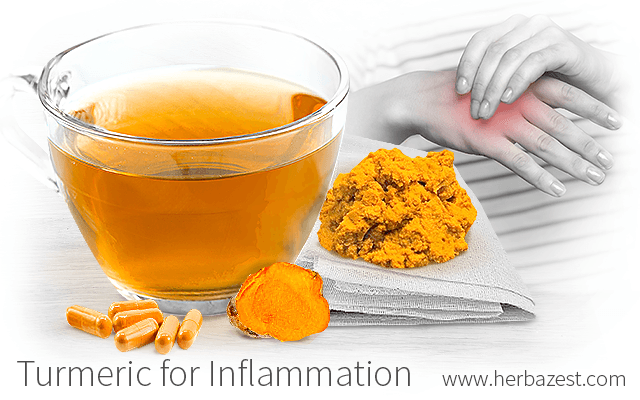Aside from popular use in Asian-inspired cuisine, turmeric can also be safe and easy to use as an anti-inflammatory treatment. In recent years, its ability to reduce inflammation has been widely studied, earning it a great deal of importance in the management of certain rheumatic and digestive disorders.
Inflammation: Causes and Triggers
Characterized by redness, tenderness, and swelling, inflammation can serve as a gateway for more serious illnesses. Research shows that many of the causes and triggers of inflammation can be attributed to a combination of lifestyle habits, environmental conditions, and genetic predisposition.
Common risk factors for inflammation are:
- Smoking
- High blood pressure
- Heightened cholesterol
- Obesity
- Hyperglycemia
- Infections
- Alcohol abuse
- Poor diet
- Dairy and gluten intolerance
However, other circumstances, apparently unrelated, can also trigger inflammatory reactions:
- Dietary changes (such as increased sugar and cholesterol intake)
- Stressful work or home environment
- Hormonal changes
- Weight gain
- Stress
- Exposure to environmental toxins (e.g., synthetic fibers, cleaning products, latex, plastics)
How to Use Turmeric for Inflammation
Although it is possible to consume it in raw or cooked form in food, turmeric can act as a powerful anti-inflammatory when used medicinally. The following are a few simple ideas on how to use turmeric for inflammation.
Turmeric's curcumin capsules. The most popular way to reap turmeric's anti-inflammatory benefits is to orally ingest its active principle, curcumin. Sometimes combined with bromelain, the recommended dosage of curcumin is approximately 500 mg three times daily.
Turmeric tea. Try turmeric tea for a simple, at-home preparation for inflammatory pain. Boil two to three teaspoons of minced turmeric root with about two cups of water. Add honey, cinnamon, lemon, or ginger to taste.
Turmeric poultice. For inflammation of the skin, it is best to use cold water to create a paste with either dried turmeric powder or fresh, finely-minced turmeric root. Wrap the paste in a light cheesecloth or apply directly to the affected areas of the skin.
Turmeric's Anti-inflammatory Action
Curcumin is turmeric's active compound. Said to be the source of turmeric's anti-inflammatory action, it works to lower histamine levels and inhibit chemical mediators of inflammation.
A study published in 2012 showed the safety and superior efficiency of curcumin as compared to diclofenac sodium.1 45 arthritic patients were split into three groups. Patients treated with curcumin alone exhibited the highest rates of improvement and reduction of tenderness and joint swelling. These results suggest the superiority of turmeric's curcumin for inflammatory arthritic pain.
As for managing the symptoms of ulcers and other gastrointestinal illness, turmeric's anti-inflammatory action has proven extremely beneficial. In a clinical study published in 2001, 45 patients received a treatment of two 300-mg turmeric capsules daily.2 A 12-week span marked the healing of stomach ulcers in all patients, while those suffering from erosions, gastritis, and dyspepsia experienced a reduction in abdominal pain and discomfort within the first two weeks.
Other Herbs for Inflammation
Although it has been shown that turmeric is good for inflammation, when combined with other known anti-inflammatory herbs, such as valerian and witch hazel, its anti-inflammatory properties could be greatly enhanced.
Pumpkin and tomato are also known for their anti-inflammatory action. Thus, for culinary consumption, pairing anti-inflammatory turmeric with these herbs - such as in a pumpkin curry - may prove particularly useful.
BECAUSE CURCUMIN IS FAT SOLUBLE, GREATER ABSORPTION OF TURMERIC'S ANTI-INFLAMMATORY AGENTS CAN BE ACHIEVED BY COOKING OR COMBINING IT WITH HEALTHY FATS OR OILS.
Turmeric is non-toxic; however, possible turmeric side effects and interactions with pharmaceutical drugs should be taken into account. Though the combination of traditional practices and modern research suggests that there is more to be discovered, the use of turmeric as an anti-inflammatory has already earned itself a place among the most important herbal treatments.
Sources
- Chronic Inflammation: Molecular Pathophysiology, Nutritional and Therapeutic Interventions, pp. 155-156
- Memorias do Instituto Oswaldo Cruz, Biological activities of curcuma longa L, 2001
- National Library of Medicine, MedlinePlus, Arthritis
- Oregon State University, Micronutrient Information Center, Curcumin Summary
- Journal of Alternative and Complementary Medicine, Safety and anti-inflammatory activity of curcumin: a component of turmeric (Curcuma longa), 2003
- Alternative Medicine Review, Anti-inflammatory properties of curcumin, a major constituent of Curcuma longa: a review of preclinical and clinical research, 2009
- American Heart Association, Inflammation and Heart Disease
Footnotes:
- Phytotherapy Research. (2012). A randomized, pilot study to assess the efficacy and safety of curcumin in patients with active rheumatoid arthritis. Retrieved September 16, 2016, from: https://pubmed.ncbi.nlm.nih.gov/22407780/
- Southeast Asian Journal of Tropical Medicine and Public Health. (2001). Phase II clinical trial on effect of the long turmeric (Curcuma longa Linn) on healing of peptic ulcer. Retrieved September 16, 2016, from: https://www.tm.mahidol.ac.th/seameo/2001_32_1/34-2714.pdf




